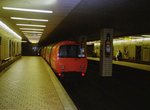Glasgow, Scotland
Overview
The Glasgow Underground first opened at 06:00 on 14th December 1896, and was called the Glasgow District Subway. At the time, it was a cable haulage railway, operating two lines, an inner circle, and an outer circle. It's this route that is still used today. The cable haulage meant that there were no points, and so the tunnels passed under the car sheds. Cars were lifted in and out of service at this point. Power for the cables was provided at the power station, located at Scotland Street, where the cables passed in and out of service.
Between 1896 and 1913, 60 cars were purchased for the subway, some being short 4 wheel trailers. Most of these were lengthened to standard size during the 1930's.
Financial difficulties led to the temporary closure of the system in early 1923, and in August 1923, Glasgow Corporation Transport, which ran the buses, trams (which were withdrawn in 1961), and trolleybuses (scrapped in 1962), took over the system. Under GCT control, the system was electrified, on the third rail principle, on 31st March 1935 (inner circle) and October 1935 (outer circle). Half the cars were converted to electric motor driving cars, the others to trailer cars, with no driving equipment. During World War II, the system was closed for 136 days, when a German bomb exploded on Beith Street bowling green, near to Merkland street station, and damaged the tunnels underneath. The scars are still evident of this today, traveling between Govan and Partick stations, where the tunnels change from cast iron segments to partly brick; this was the site of the bomb explosion.
During the late 1960's and the 1970's, the system was run down, with the stations looking gloomy, with peeling paintwork, and very grimy. The wooden bodied trains were now nearly 80 years old, and reliability was becoming a major concern. In 1974, GCT was replaced by Strathclyde Passenger Transport executive, and this body still runs the system today. That same year, a plan to modernise the subway was unveiled, and the system closed on March 21st 1977. Even this was a week earlier than intended, due to cracks appearing in the roof of Govan Cross station, associated with construction of the new platforms on the same site.
Three stations were renamed. Govan Cross became Govan; Partick Cross became Kelvinhall, and Copeland Road was renamed Ibrox, advertising its proximity to Ibrox Stadium, home of Glasgow Rangers soccer club. In addition, Merkland Street station was closed, and a new station was built 15 meters away, called Partick. The new site offered better interchange with British Rail services at the same station.
33 new power cars were ordered, and these were built by Metro Cammel. The old cars were scrapped, except for car 55, which is retained at the Broomloan depot, cars 1, 39, and half of car 4 site in the Glasgow Museum of Transport, whilst car 7 is at the National Railway Museum in York. Car 41 was split in two longways, and is mounted on the wall at Buchanan Street station, the most novel disposal of a train ever!
The stations were fully modernised, and as well as Partick, 5 other stations received an extra platform, to cope with crowds. At Govan, St Enoch, and Partick, flank platforms were built, these being on the same side of the train in direction of travel. At Ibrox, Buchanan Street, and Hillhead, only one flank platform could be provided, so the island platform was retained for the other circle. The lifting pit at the car sheds was decked over, and new turn out chambers were created; these have pointwork, and cars come out of service via these chambers (north and south), and head up ramps into the open air to the depot yard. From here, trains reverse into the stabling shed, or the maintenance shed.
To cope with increased demand, and a desire to make all trains 3 cars long, eight trailer cars were purchased in 1992. These are similar to the 33 power cars, but have no cab. They were built by Hunslet-Barclay, at Kilmarnock, Scotland. In 1996, two power cars were repainted into the original GDS livery, for the centenary of the system, by now known as the Underground. But in 2002, SPT decided to rename it the subway again! The cars have received a revised paint scheme, with SPT Subway branding on the sides of the cars.
Route Map
Photos By Location
Photo locations: Hillhead, Kelvinbridge, St. George's Cross, Cowcaddens, Buchanan Street, St. Enoch, Bridge Street, West Street, Shields Road, Kinning Park, Cessnock, Ibrox, Govan, Merkland Street, Partick, Kelvinhall, Broomloan Depot
Photo Gallery
| Five Random Images | ||||
 Image 10270 (56k, 820x553) Photo by: Tristan Zieley Location: Shields Road |  Image 10274 (50k, 820x553) Photo by: Tristan Zieley Location: St. Enoch |  Image 89135 (246k, 1044x788) Photo by: Dave Carson Location: Kelvinhall |  Image 111153 (183k, 1044x684) Photo by: Dave Carson Location: Broomloan Depot |  Image 126110 (351k, 1044x788) Photo by: Brian J. Cudahy Location: St. George's Cross |
Links
Official Site - Strathclyde Passenger Transport. The official site of Strathclyde Passenger Transport, including schedules, fares, and more.
Page Credits
By Robert Clark. Route Map by Seth Morgan.
